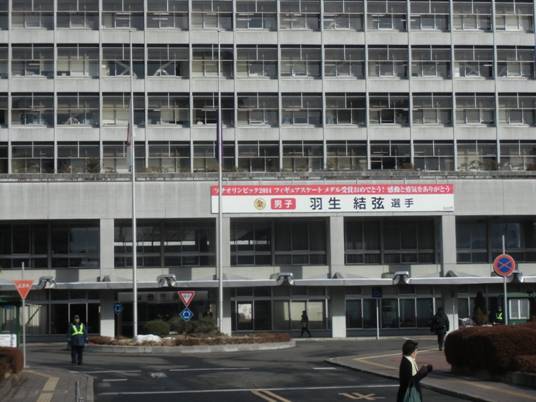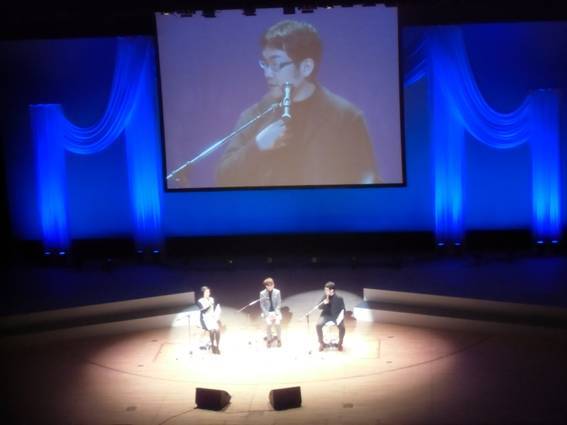Slowly Hurrying
~Connecting, Communicating, and Sustaining What Matters~
Activities of the Tohoku Recovery Support Network
On March 11, 2014, the atmosphere felt different from the morning. At 8 a.m., stepping off the train at Sendai Station, I suddenly felt a profound stillness. Walking through the city toward my office in the painfully cold air, I saw the Japanese flag countless times. Yes, Miyagi Prefecture had designated March 11th as "Miyagi Memorial Day" starting this year, with schools closed so elementary, junior high, and high school students could participate in memorial services. I realized anew that this solemn, subdued atmosphere stemmed from that.

 |
(Sendai City Hall and office buildings on the morning of 3.11. National flags were displayed, enveloping the city in an atmosphere unlike any previous 3.11.)
|
At 2:46 PM, I was at the venue for the "3.11 Great Earthquake Memorial Event" (hosted by Miyagi Prefecture, Kahoku Shimpo, and others) scheduled for that evening. Shortly before, Mr. Koichi Yamadera, the master of ceremonies from Miyagi Prefecture, began muttering to staff, "Is the timing okay?" But for a while, everyone was so absorbed in rehearsal they didn't grasp his meaning. Freelance announcer Shoji-san, who was also hosting, noticed two minutes before and hurriedly led everyone in a moment of silence. I felt intense remorse, having often said that fading memories were the greatest challenge.
Meanwhile, it was reported that people stopping to observe silent prayers on streets, in shops, and everywhere else were more noticeable than in previous years. An employee at a department store shared, "At 2:46, all the customers inside the store simultaneously turned toward the sea and observed a silent prayer. It was a scene I'd never seen before." This is likely also an effect of the establishment of "Miyagi Memorial Day." Remembering is important.
This fourth anniversary of 3.11 likely saw each person's circumstances and feelings change, little by little but surely. The "3.11 Great Earthquake Memorial Event" is also in its second year, following last year. It originated from a request by Miyagi Prefecture Governor Murai. The Kahoku Shimpo newspaper handled everything from planning to execution, with us assisting. We carried it out with the support of companies who agreed with its purpose. Typically, memorial services or commemorative ceremonies might be thought of as events budgeted and organized by the local government itself. Certainly, that is the overwhelmingly common case. However, there is also value in events like this, created through the joint efforts of businesses and the citizens of the prefecture.
The keyword for this year was "Toward Tomorrow, Toward the Future." Having passed the three-year mark, we entered a phase where, moving beyond basic recovery, we began looking ahead and engaging in various creative reconstruction activities. The concept was to make this 3.11 a kickoff for that new phase.
Despite the bitter cold, comparable to the dead of winter, participants more enthusiastic than last year formed a line over an hour before the doors opened. The event closed to great success in just about two and a half hours, packed with rich content including poetry readings and concerts. Both performers, Ai Kawashima and Mayu Okamoto, are actively involved in recovery support activities, and their passionate feelings came through powerfully in their songs and recitations.
(Scene from the "3.11 Great Earthquake Memorial Event")
Ms. Aoi Kawashima chose her words carefully, speaking as if directly to each person in the audience, sharing her thoughts for the victims: "To those affected, I want to say 'It's okay,' not 'Hang in there.'"
Governor Murai, in his closing remarks, expressed his characteristic forward-looking resolve: "Moving forward, we aim for creative reconstruction and will take on various challenges. You are the protagonists of this effort." The venue united in solidarity.
3.Media coverage around the 11th often focused on individual survivors, highlighting the current state and challenges of the disaster-affected areas through their stories. This approach is undoubtedly important. However, many people within local governments and administrations are also working tirelessly, without a single day off, on reconstruction. This memorial event marked the beginning of a new chapter: not a top-down relationship between residents and administration, or between authorities and common people, nor a sense of shifting responsibility. Instead, it signaled a future where each party stands firmly on its own ground, sincerely and equally facing each other to jointly create a new Tohoku.
 (MCP Bureau Area Solutions Department, Tohoku Recovery Support Network (*), Sendai Representative: Yasuhiro Kitade)
(MCP Bureau Area Solutions Department, Tohoku Recovery Support Network (*), Sendai Representative: Yasuhiro Kitade)
※Tohoku Recovery Support Network: A cross-functional virtual project team launched within Dentsu Inc. in August 2011. Following the Great East Japan Earthquake on March 11, 2011, the team explored how Dentsu Inc. could provide recovery support locally through its core business. Currently, with the MC Planning Bureau Area Solutions Department as its core unit, the network comprises six members including staff from the Radio, Television & Entertainment Bureau and the 15th Sales Bureau. Collaborating with other Dentsu Inc. departments and Dentsu East Japan Inc., it primarily operates in the three prefectures of Iwate, Miyagi, and Fukushima. Over the two and a half years since its launch, the team's activities have been diverse, including reconstruction-related projects with local governments and central ministries, reconstruction events in collaboration with local media, and reconstruction support for local private companies.







 (MCP Bureau Area Solutions Department, Tohoku Recovery Support Network (*), Sendai Representative: Yasuhiro Kitade)
(MCP Bureau Area Solutions Department, Tohoku Recovery Support Network (*), Sendai Representative: Yasuhiro Kitade)